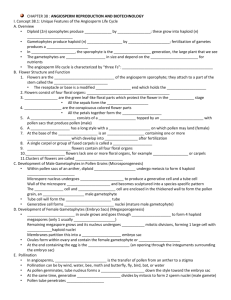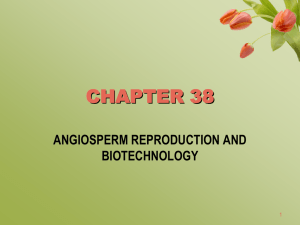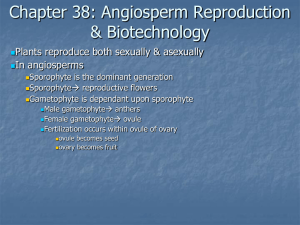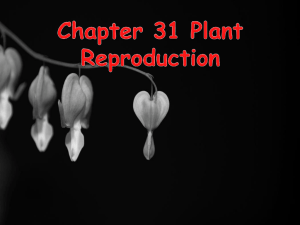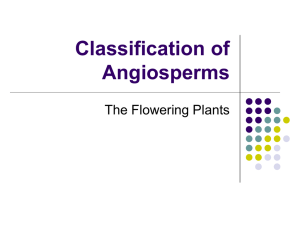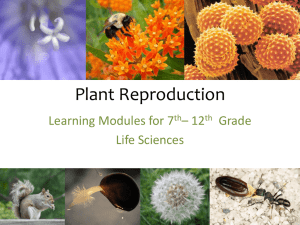Ch 38 Reproduction & Biotech
advertisement
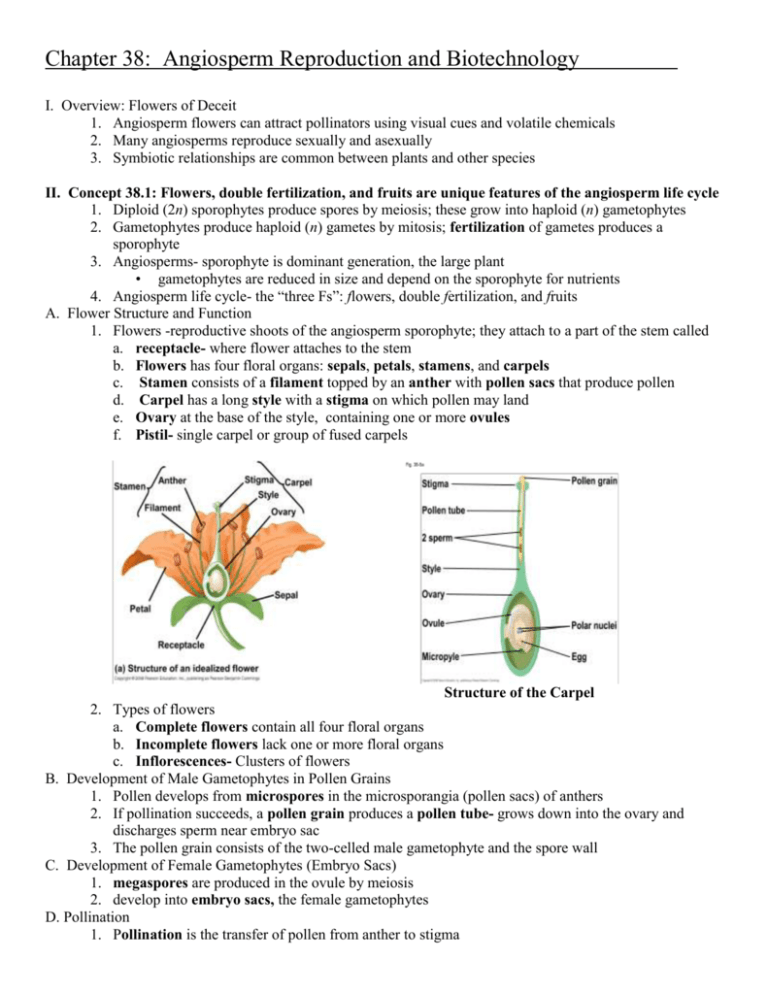
Chapter 38: Angiosperm Reproduction and Biotechnology I. Overview: Flowers of Deceit 1. Angiosperm flowers can attract pollinators using visual cues and volatile chemicals 2. Many angiosperms reproduce sexually and asexually 3. Symbiotic relationships are common between plants and other species II. Concept 38.1: Flowers, double fertilization, and fruits are unique features of the angiosperm life cycle 1. Diploid (2n) sporophytes produce spores by meiosis; these grow into haploid (n) gametophytes 2. Gametophytes produce haploid (n) gametes by mitosis; fertilization of gametes produces a sporophyte 3. Angiosperms- sporophyte is dominant generation, the large plant • gametophytes are reduced in size and depend on the sporophyte for nutrients 4. Angiosperm life cycle- the “three Fs”: flowers, double fertilization, and fruits A. Flower Structure and Function 1. Flowers -reproductive shoots of the angiosperm sporophyte; they attach to a part of the stem called a. receptacle- where flower attaches to the stem b. Flowers has four floral organs: sepals, petals, stamens, and carpels c. Stamen consists of a filament topped by an anther with pollen sacs that produce pollen d. Carpel has a long style with a stigma on which pollen may land e. Ovary at the base of the style, containing one or more ovules f. Pistil- single carpel or group of fused carpels Structure of the Carpel 2. Types of flowers a. Complete flowers contain all four floral organs b. Incomplete flowers lack one or more floral organs c. Inflorescences- Clusters of flowers B. Development of Male Gametophytes in Pollen Grains 1. Pollen develops from microspores in the microsporangia (pollen sacs) of anthers 2. If pollination succeeds, a pollen grain produces a pollen tube- grows down into the ovary and discharges sperm near embryo sac 3. The pollen grain consists of the two-celled male gametophyte and the spore wall C. Development of Female Gametophytes (Embryo Sacs) 1. megaspores are produced in the ovule by meiosis 2. develop into embryo sacs, the female gametophytes D. Pollination 1. Pollination is the transfer of pollen from anther to stigma 2. Can be by wind, water, bee, moth and butterfly, fly, bird, or bat 3. Double Fertilization a. Pollen grain lands on stigma &makes a pollen tube extending from style to ovary b. Double fertilization -two sperm leave the pollen tube & enter embryo sac c. One sperm fertilizes the egg d. The other combines with polar nuclei, makes triploid (3n) food-storing endosperm E. Seed Development, Form, and Function 1. Fertilized ovules developed into seeds 2. The ovary develops into fruit enclosing the seed(s) 3. Endosperm Development a. Happens first b. Most monocots & some eudicots stores nutrients for seedling in endosperm c. Some eudicots store food in the cotyledons 4. Embryo Development a. First mitotic division is transverse & splits fertilized egg into a basal cell and a terminal cell F. Structure of the Mature Seed - dormant 1. seed coat- hard, protective outer coat 2. Structure a. Cotyledons- first leaves, seed leaves b. Epicotyls- the embryonic axis (body) above the cotyledons c. Hypocotyls- the embryonic axis below the cotyledons d. Radical- (embryonic root); the embryonic axis ends in the radicle 3. In some eudicots, (beans) embryo is embryonic axis attached to two thick cotyledons (seed leaves) 4. A monocot embryo has one cotyledon a. Two sheathes enclose the embryo of a grass seed: • a coleoptile covering the young shoot and a • coleorhiza covering the young root G. Seed Dormancy: An Adaptation for Tough Times 1. Seed dormancy increases chance germination occurs at best time and place for the seedling 2. Environmental cues, such as temperature or lighting changes, break dormancy H. Seed Germination and Seedling Development 1. Germination depends on imbibition, the uptake of water due to low water potential of the dry seed 2. The radicle (embryonic root) emerges first 3. Next, the shoot tip breaks through the soil surface • In many eudicots, a hook forms in the hypocotyl, and growth pushes the hook above ground • The hook straightens and pulls the cotyledons and shoot tip up • In maize and other grasses, which are monocots, the coleoptile pushes up through the soil J. Fruit Form and Function 1. fruit develops from ovary 2. It protects seeds and aids in seed dispersal by wind or animals 3. Dry fruit- ovary dries out at maturity, or 4. Fleshy fruit- ovary becomes thick, soft, and sweet at maturity 5. Fruits are also classified by their development: a. Simple, a single or several fused carpels b. Aggregate, a single flower with multiple separate carpels c. Multiple, a group of flowers called an inflorescence 6. An accessory fruit contains other floral parts in addition to ovaries 7. Fruit dispersal mechanisms include water, wind, & animals III. Concept 38.2: Plants reproduce sexually, asexually, or both 1. Many angiosperm reproduce both asexually and sexually 2. Sexual reproduction - offspring are genetically different from parents 3. Asexual reproduction- (vegetative reproduction ) gives a clone of genetically identical organisms 4. Mechanisms of Asexual Reproduction a. Fragmentation, parent plant breaks into parts that develop into whole plants b. parent plant’s root system makes adventitious shoots that become separate plants c. Apomixis is the asexual production of seeds from a diploid cell A. Advantages and Disadvantages of Asexual Versus Sexual Reproduction 1. Asexual - beneficial to a successful plant in a stable environment • But, is vulnerable to local extinction if there is an environmental change 2. Sexual reproduction- genetic variation makes evolutionary adaptation possible 3. Few seedlings survive B. Mechanisms That Prevent Self-Fertilization 1. Dioecious species- staminate (flowers w/ stamens) and carpellate flowers on separate plants 2. Stamens and carpels may mature at different times or are arranged to prevent selfing 3. Self-incompatibility, a plant’s ability to reject its own pollen • Some plants reject pollen that has an S-gene matching an allele in the stigma cells • Recognition of self pollen triggers a signal to block growth of a pollen tube C. Vegetative Propagation and Agriculture 1. Most methods are based on the ability of plants to form adventitious roots or shoots 2. Clones from Cuttings a. May be asexually reproduced from plant fragments called cuttings b. A callus- mass of dividing undifferentiated cells, forms where stem is cut, and adventitious roots 3. Grafting a. A twig or bud can be grafted onto a plant of a closely related species or variety • stock provides the root system • scion is grafted onto the stock 4. Test-Tube Cloning and Related Techniques a. Transgenic plants are genetically modified (GM) to express a gene from another organism b. Protoplast fusion is used to create hybrid plants by fusing protoplasts, plant cells with their cell walls removed IV. Concept 38.3: Humans modify crops by breeding and genetic engineering 1. Hybridization is common in nature and has been used by breeders to introduce new genes A. Plant Breeding 1. Mutations can arise spontaneously or can be induced 2. Plants with beneficial mutations are used in breeding experiments 3. Desirable traits can be introduced from different species or genera B. Plant Biotechnology and Genetic Engineering 1. Plant biotechnology has two meanings: a. Refers to innovations in the use of plants to make useful products b. Refers to use of GM (genetically modified) organisms in agriculture and industry C. Reducing World Hunger and Malnutrition 1. Genetically modified plants may increase the quality and quantity of food worldwide 2. Transgenic crops have been developed that: a. Produce proteins to defend them against insect pests b. Tolerate herbicides c. Resist specific diseases 3. Nutritional quality of plants is being improved 4. “Golden Rice” is a transgenic variety, addresses vitamin A deficiencies among the world’s poor D. Reducing Fossil Fuel Dependency 1. Biofuels are made by the fermentation and distillation of plant materials such as cellulose 2. Biofuels can be produced by rapidly growing crops 3. The Debate over Plant Biotechnology 4. Some biologists are concerned about risks of releasing GM organisms into the environment 5. One concern: genetic engineering may transfer allergens from a gene source to a plant used for food 6. Ecologists concerned- growing of GM crops might have unforeseen effects on nontarget organisms G. Addressing the Problem of Transgene Escape 1. Perhaps the most serious concern is the possibility of introduced genes escaping into related weeds through crop-to-weed hybridization 2. Efforts are underway to prevent this by introducing: a. Male sterility b. Apomixis c. Transgenes into chloroplast DNA (not transferred by pollen) d. Strict self-pollination

